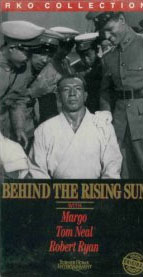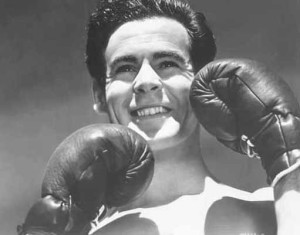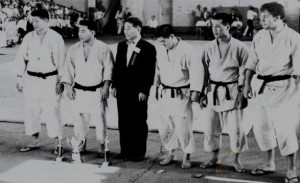
I have been looking for a film in which an American Boxer fights a japanese martial artist during World War II. Diligence pays off. The film is titled Behind The Rising Sun and stars Robert Ryan as the boxer, Lefty O’Doyle. The Japanese actors in the film are all uncredited, the principal japanese roles in the film are played by American character actors. This is one of the films I saw after school on Channel 7 when I got home and was supposed to be doing home work. It painted a bleak picture of the Japanese actions prior to WW II.
martial artist during World War II. Diligence pays off. The film is titled Behind The Rising Sun and stars Robert Ryan as the boxer, Lefty O’Doyle. The Japanese actors in the film are all uncredited, the principal japanese roles in the film are played by American character actors. This is one of the films I saw after school on Channel 7 when I got home and was supposed to be doing home work. It painted a bleak picture of the Japanese actions prior to WW II.
Here is a brief synopsis of the film:
“Cornell-educated Taro Seki returns to Japan just as the war party gains control. He hopes to work for American engineer O’Hara, and falls for his secretary Tama, but he is drafted. War service in China finally hardens Taro to atrocities, and he returns to Japan a changed man. His father, now a cabinet minister, feels remorse at what war has done to his son and country, but too late to save Taro’s foreign friends.”
The film is accused of being the worst kind of propaganda. See it for yourself and you tell me.
What is most interesting about this film is the same year it premiered a fight was arranged between an American Wrestler and Masato Tamura, a name that is mentioned over and over in my interviews, most especially for his clandestine lessons to black martial arts students in the 1950s which gave rise to the the wider participation of black martial artists in Chicago.
Judo Battles Wrestling: Masato Tamura and Karl Pojello, Chicago 1943
Read that and you get a sense of the heroic individual that Mas Tamura really was. Absolutely outstanding. The article gives you a sense of the times he survived and how he emerged with a strong sense of humanism in spite of the vile anti-Japanese mood that existed in the US during WWII. Mas Tamura is in the center with the suit in the photo below. This picture is from the 1956 Chicago Yudanshakai. Mas Tamura was the coach of the 5 man event winners. The article is an example of how strong the presence of Asians martial arts were in Chicago in the 30s and 40s.
 The good stuff is appearing. I am setting a great foundation for the story, I am feeling.
The good stuff is appearing. I am setting a great foundation for the story, I am feeling.

Thanks for bringing this one to my attention!<BR/><BR/>It sounds like a very intriguing example of film history, albeit the kind that amply demonstrates why we must be in a constant process to improve the way we as a society construct our narratives for public artistic dialogue on our screens and shelves.